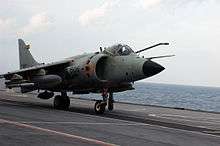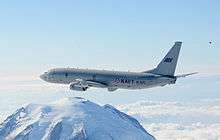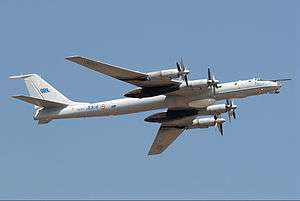Indian Naval Air Arm
| Indian Naval Air Arm भारतीय नौसेना वायु शाखा | |
|---|---|
| Founded | 1948 [1] |
| Country | India |
| Type | Naval Air Arm |
| Size |
5,000 personnel[2] Approx. 212 aircraft[3] |
| Part of | Indian Navy |
| Commanders | |
| Current commander | Rear Admiral Vijay Shankar, Assistant Chief of Naval Staff (Air).[4] |
| Insignia | |
| Roundel |
 |
| Fin flash |
|
| Aircraft flown | |
| Bomber | Tupolev Tu-142 |
| Fighter | Mikoyan MiG-29K |
| Interceptor | Mikoyan MiG-29K |
| Patrol | Ilyushin Il-38, Boeing P-8 |
| Reconnaissance | Ilyushin Il-38, Boeing P-8 |
| Trainer | BAE Hawk, HAL Kiran, Pilatus PC-7, Pipistrel Virus |
| Transport | Dornier Do 228 |
The Indian Naval Air Arm is a branch of Indian Navy which is tasked to provide an aircraft carrier based strike capability, fleet air defence, maritime reconnaissance, and anti-submarine warfare.
Flag Officer Naval Aviation (FONA) at Goa appears to direct the field operations of the air arm. FONA also serves as the Navy's Flag Officer Goa Area (FOGA).[5]
History
_launches_an_Alize_aircraft_during_Indo-Pakistani_War_of_1971.jpg)
The first naval air station, INS Garuda, was inaugurated in Cochin on 11 May 1953.[6] This went hand-in-hand with the commissioning of the No.550 Squadron,[7] utilising Short Sealand aircraft.[8] and Fairey Firefly aircraft[9]
1960 saw the No.300 White Tigers Squadron,[10] consisting of Sea Hawks[11] aircraft being commissioned.
In the very next year (1961), INS Vikrant (formerly HMS Hercules) was acquired by the Indian Navy.[12] The Vikrant's initial airwing consisted of British Hawker Sea Hawk fighter-bombers and a French Alize anti-submarine aircraft. On 18 May 1961, the first jet landed on board, piloted by Lieutenant (later Admiral) R H Tahiliani. That year, the No.310 Cobras Squadron (consisting of Alize aircraft[11][13]) was commissioned. After playing an important role in several major Indian military actions, specifically the liberation of Goa and the India-Pakistan war in 1971, she was decommissioned in January 1997[14] and turned into a museum ship.[15]
In 1976, the Indian Air Force handed over Super Constellation[16] aircraft to the No.312 Albatross Squadron[17] in Dabolim, Goa. Being fairly old aircraft at that point, these were withdrawn from active service by 1983. To replace them in the maritime patrol role, Soviet aircraft were acquired. The No. 315 Winged Stallions Squadron was commissioned in 1977 with the Ilyushin Il-38 aircraft.[18]
In December 1961, INS Vikrant participated in Operation Vijay, the liberation of Goa from Portugal. Its role was primarily to deter foreign naval intervention during the 40-hour-long military action.[19]
INS Vikrant played a major role in the successful Naval blockade of East Pakistan.[20] Stationed off the Andaman & Nicobar Islands escorted by the Leopard class frigate INS Brahmaputra, as well as INS Beas, the Vikrant redeployed towards Chittagong at the outbreak of hostilities.[21] The morning of 4 December 1971, the eight Sea Hawk aircraft on the Vikrant launched an air raid on Cox's Bazaar from 60 nm away. That evening, the air group struck Chittagong harbour. Other strikes targeted Khulna and Mongla. A PTI message is supposed to have read, "Chittagong harbour abalze as ships and aircraft of the (Pakistan) Eastern Naval Fleet bombed and rocketed. Not a single vessel can be put to sea from Chittagong". Air strikes staged from the Vikrant continued till 10 December 1971.
Given naval intelligence that indicated the intent of the Pakistan Navy to break through the Indian Naval blockade using camouflaged merchant ships, the Vikrant's Sea Hawks struck shipping in the Chittagong and Cox's Bazar harbours, sinking or incapacitating most merchant ships there.
The Hughes 269 helicopter was previously in service for training.

The BAE Sea Harrier inducted in the 1980s operated from the INS Viraat.[22] until March 6, 2016,[23][24][25] The BAE Sea Harrier FRS Mk.51 / T Mk.60 flew with the INAS 300 and INAS 552 squadrons of the Indian Navy. The Sea Harriers are armed with the Matra Magic-II AAM and the Sea Eagle Anti-ship missiles. The aircraft were upgraded with the Elta EL/M-2032 radar and the Rafael Derby BVRAAM missiles.[26]
The Naval Aviation Museum located in Bogmalo, 6 km from Vasco da Gama, Goa, India showcases the history of the Naval Air Arm.
Aircraft inventory
Fixed-wing aircraft
Mikoyan MiG-29K

The Mikoyan MiG-29K program was revived by Russia in response to the decision of the Indian Navy to acquire the Soviet aircraft carrier Admiral Gorshkov.[27][28] As reported by MiG Bureau, the Indian Navy's association with the MiG-29K began in Apr 2002 when a team led by Commander Gupta reached Moscow to evaluate the MiG-29K prototype for possible induction into the Indian Navy. The Team evaluated the aircraft on ground as well as in the air (the flight evaluation was conducted by a Navy Test Pilot Commander Ahuja). Some other aircraft were also evaluated but the MiG-29K was chosen. On 20 January 2004, the Indian Navy signed a contract for 12 single-seat MiG-29K and 4 two-seat MiG-29KUB. The first MIG-29K for the Indian Navy took flight on 22 January 2007. The MIG-29 KUB (two-seat trainer) is similar to the MIG-29K but with reduced operational range. The aircraft will be fielded on the aircraft carrier INS Vikramaditya.[29]
The first squadron, INAS 303, christened "Black Panthers",[30] was commissioned on 11 May 2013.[31] The delivery of the aircraft to the Indian Navy started in 2009, and by July 2015, 33 had been inducted, with 12 more to be delivered.[32]
The fighter plane is different from the MiG-29 flown by Indian Air Force. The aircraft has been modified for aircraft carrier operation by hardening the undercarriage. It also has much better 'over-the-nose' vision to make it easy to land aboard a carrier at a high angle of attack. Modifications made for Indian Navy requirement featured Zhuk-ME radar, RD-33MK engine, combat payload up to 5,500 kg, 13 hardpoints (inclusive of the multi-lock bomb carriers), additional fuel tanks situated in dorsal spine fairing and wing LERXs, increased total fuel capacity by 50% comparing to first variant of MiG-29 and an updated 4-channel digital fly-by-wire flight control system. With special coatings, the MiG-29K radar reflecting surface is 4–5 times smaller than of basic MiG-29. Cockpit displays consist of wide HUDs, 3 colour LCD MFDs (7 on the MiG-29KUB), a French Sigma-95 satellite GPS module and Topsight E helmet-mounted targeting system compatible with the full range of weapons carried by the MiG-29M and MiG-29SMT.[33]
Boeing P-8I Neptune

New Delhi and Boeing have signed a $2.1 billion contract to deliver 12 P-8I Neptune for anti-submarine operations. The new aircraft will replace a fleet of Russian-manufactured Tupolev-142M planes. P-8I varies from the P-8A, with the Magnetic anomaly detector (MAD) has been kept intact while an aft-mounted radar provides 360-degree aerial radar surveillance capability. Many of the communication and other devices on-board are developed by Bharat Electronics Limited. The first squadron was formed with eight aircraft. When the remaining four join the force, the Tu-142 will be decommissioned.[34]
Tupolev Tu-142

The Indian Navy operates eight Tu-142 aircraft, which entered service in 1988. The aircraft have been upgraded, helping to extend the service life of the aircraft by sixteen years. One of the upgraded aircraft has been handed over to the Indian Navy.[35] The aircraft operate from INS Rajali and INS Hansa. Two Tu-142 aircraft are being fitted with the air-launched version of the BrahMos. The aircraft will be the test platform for the BrahMos cruise missiles. The integration and tests of the missile is expected to be completed by 2010.[36] Eight aircraft will be fitted with the BrahMos cruise missiles.[37] The Tu-142 aircraft are in the process of being replaced by the Boeing P-8I Neptune long range maritime aircraft.
Ilyushin Il-38
Indian Navy operates 5 Il-38 planes. Currently they are being upgraded to use Sea Dragon suite.
Helicopters

HAL Dhruv; developed by Hindustan Aeronautics Limited, the Navy received its first Dhruvs on 28 March 2002.[38][39] It is expected to receive a total of 120 units to replace the Chetak helicopters in service. The naval variant is fitted with the Super Vision-2000 maritime radar, capable of detecting targets with low radar cross section at a range of 200 km. The anti-submarine version of the helicopter is fitted with dunking sonar, torpedoes, depth charges. The helicopter may also be fitted with the missiles for anti-ship roles. However, in 2008, Indian Navy pronounced Dhruv unsuitable for its role as an ASW platform. Indian Navy will continue to procure Dhruv as a multi-role utility platform. During the commissioning ceremony Vice Admiral Sinha said that "In the Navy, Dhruv helicopters has transformed into an advanced search and rescue (SAR) helicopter also used for missions like heliborne operations, and armed patrol with night vision devices. Such machines in the inventory have become imperative for the Navy given the scenario of low intensity maritime operations (LIMO) and coastal security construct."[40] In 2013 Indian Navy showed keen interest in the armed version of the HAL Rudra. Impressed with the Dhruv's sensors which were able to track ships and also read their names at ranges of 12 to 14 km. The Navy may induct 20 more helicopters into service.[41]
Kamov Ka-25, Kamov Ka-28, and the Kamov Ka-31: The Ka-25 was acquired by the Indian Navy in 1980 for anti-submarine warfare, but had severe technological limitations. The Ka-28s were acquired in the mid-80s, and were said to be a quantum leap over their predecessors from an ASW standpoint. The Ka-31[42] takes the Kamov capabilities even further by enabling real-time network-centric warfare for the Indian Navy.
Westland Sea King and the Sikorsky SH-3 Sea King: Used principally for anti-submarine warfare (ASW) and search & rescue roles,[43] the helicopter fleet operate from INS Garuda (Kochi) as well as INS Kunjali-II (Mumbai) air stations. US sanctions on India in response to India's nuclear tests resulted in a large part of the Sea King fleet being grounded for want of spare parts. Seventeen of the Sea King helicopters will be upgraded. The upgrade will feature day and night capability, capability to work in adverse weather conditions, integration of two anti-ship missiles with a range of fifty kilometres and a new radar.[44]
Aérospatiale SA 316 Alouette III: Also known as the Chetak, these choppers have seen active service in the Navy as well as the Coast Guard. They are carried on several combatant as well as non-combatant ships. They are also operated from and maintained at the INS Kunjali-II and INS Utkrosh Naval Air Stations in Mumbai and Port Blair respectively.
UAVs
The Indian Navy operates at least two squadrons of Heron and Searcher Mk-II UAVs, based in Kochi (INAS 342) and Porbandar (INAS 343).[45][46] There are plans to have at least two more squadrons of UAVs.[47] UAVs are controlled from ships to increases the range of surveillance. There are plans to introduce rotary UAVs into the Indian Navy.[48] These UAVs will have higher endurance and load carrying capability resulting in better reconnaissance capabilities.[49]
Future aircraft
- Fixed-wing aircraft
- HAL Tejas: The naval variant of the Tejas will have strengthened landing gear and other necessary modifications for service on an aircraft carrier. Trials are being carried out at the Shore Based Test Facility (SBTF) constructed at the naval airbase INS Hansa in Goa. The Indian Navy plans has a requirement for 40 or 50 Tejas to equip two front-line squadrons to operate from aircraft carriers INS Vikramaditya and INS Vikrant.[50][51] The Indian navy has placed an order for its first six Tejas at an approximate cost of ₹1.5 billion (US$22.3 million) per aircraft, the total order amounts to ₹9 billion (US$133.7 million).[52]
- 17 Hawk Trainer: 10 delivered, rest by 2016-2017'[53][54]
- HAL HJT-36 trainer aircraft to replace the older HAL Kiran.[55]
- Pipistrel Virus SW 80 - Indian Navy ordered total 12 Pipistrel Virus SW 80 to train it's cadets.[56][57]
- Medium Range Maritime Reconnaissance Aircraft: The Indian Navy issued an RFP for six medium-range maritime reconnaissance (MRMR) aircraft. The possible contenders are; the ATR-72MP/ATR-42MP, the EADS C-295MPA/C-235MPA, the Dassault's Falcon 900MPA and the Embraer P-99A. The procurement number has been enhanced to 9 as per news reports in February 2012.[58]
- ShinMaywa US-2: Indian navy intends to acquire 12 US-2 amphibian aircraft for conducting long-range search-and-rescue operations at cost of $1.65 billion. 2 US-2 will be directly imported and remaining 10 will be assembled locally in India.[59]
- Helicopters
- Naval Multi-role Helicopter (NMRH): 16 S-70B Seahawk helicopters have been selected for the tender with an additional 8 helicopters as options. They will replace the Westland Sea King[60][61]
- Naval Utility Helicopter (NUH): In 2012 the Indian Navy launched a US$1 billion global tender for the purchase of 56 light naval utility helicopters, entering service starting 2016 to replace the ageing HAL Chetak. The tender was issued to AgustaWestland, Bell Helicopter, Boeing, Eurocopter, Kamov and Sikorsky.[62] However it was reported that the tender was cancelled in August 2014.[63]
- UAVs
- The IAI-HAL NRUAV is a requirement for an unmanned helicopter capable of conducting ISR missions.[64]
Structure
Flag Officer Naval Aviation (FONA) controls training, maintenance and other functions of naval aviation. Aircraft yards at Kochi, Kerala and Dabolim, Goa are responsible for maintaining the fleet's air arm. An exclusive base, INS Shikra for helicopters was commissioned in Mumbai.[65]
To protect and preserve India's growing trade with Southeast Asia and offer a defence against increasing Chinese naval presence in the Bay of Bengal, a new naval base is being built near Visakhapatnam.[66] It is expected to be capable of harbouring two aircraft carriers, including the planned new Vikrant-class aircraft carrier. There are two more naval air stations, INS Rajali and INS Parundu in Tamil Nadu.
Southern Command has at least one airfield, INS Garuda, in Kochi, Kerala.[67] The Hindu reported on 2 February 2009 that a new airbase will be set up in Muscat, Oman to tackle piracy in the Gulf of Aden.[68] Three years later in 2012 it is not clear whether any action has been taken on this proposal. The southernmost naval air station, INS Bazz was formally opened on 31 July 2012 by the Chief of the Indian Navy at Cambell Bay in Andaman and Nicobar Islands. With the commissioning of this station, the country acquired increased capability to keep vigil on the vital maritime channel of the Straits of Malacca.[69]
See also
- Indian Coast Guard
- List of Indian naval aircraft
- List of active Indian military aircraft
- Naval ranks and insignia of India
- Middle Ground Coastal Battery
- Project Seabird
- Indian Maritime History
- Naval Aviation Museum (India)
- Army Aviation Corps (India)
References
- ↑ "The Naval Air Arm". The Indian Navy. Retrieved 21 July 2014.
- ↑ Bharat-Rakshak - Indian Navy - Administrative Structure, bharat-rakshak.com
- ↑ Flightglobal - World Air Forces 2015 (PDF), Flightglobal.com
- ↑ Bharat-Rakshak.com: NAVY SENIOR APPOINTMENTS & OFFICERS LIST
- ↑ Indian Navy Information Resource and Facilitation Centre (2006-05-18). "Indian Navy Information Resource and Facilitation Centre - Content". Irfc-nausena.nic.in. Retrieved 2013-06-27.
- ↑ ''Military Year-book'' – India 1965. Books.google.com. Retrieved 2013-06-27.
- ↑ Bharat-Rakshak.com – Indian Navy Timeline – "11 May 1953: First Naval Air Station, INS Garuda, inaugurated at Cochin. No.550 Squadron (consisting of Sealand and Firefly aircraft) commissioned" Archived 19 November 2007 at the Wayback Machine.
- ↑ Naval Aviation Museum, Dabolim, Goa, India – http://www.warbirdsofindia.com Archived 5 July 2008 at the Wayback Machine.
- ↑ Naval Aviation Museum, Dabolim, Goa, India – http://www.warbirdsofindia.com Archived 5 July 2008 at the Wayback Machine.
- ↑ Bharat-Rakshak.com – Indian Navy Timeline – "1960: No.300 White Tigers Squadron (consisting of Sea Hawk aircraft) commissioned." Archived 19 November 2007 at the Wayback Machine.
- 1 2 Naval Aviation Museum, Dabolim, Goa, India – http://www.warbirdsofindia.com Archived 5 July 2008 at the Wayback Machine.
- ↑ ''Military Year-book'' – India 1965. Books.google.com. Retrieved 2013-06-27.
- ↑ ''Aircraft Carriers: The World's Greatest Naval Vessels and Their Aircraft'' By Richard Jones, Chris Bishop, Chris Chant, Christopher Chant. Books.google.com. 2004-10-15. Retrieved 2013-06-27.
- ↑ ''Students' Britannica India'' By Dale Hoiberg, Indu Ramchandani. Books.google.com. Retrieved 2013-06-27.
- ↑ INS Vikrant – the naval museum Posted by Nita
- ↑ Naval Aviation Museum, Dabolim, Goa, India – http://www.warbirdsofindia.com Archived 19 July 2008 at the Wayback Machine.
- ↑ Bharat-Rakshak.com – Indian Navy Timeline – "1976: No.312 Albatross Squadron (consisting of Super Constellation aircraft) commissioned." Archived 19 November 2007 at the Wayback Machine.
- ↑ Bharat-Rakshak.com – Indian Navy Timeline – "01 October 1977: No.315 Winged Stallions Squadron (consisting of IL-38 aircraft) commissioned." Archived 19 November 2007 at the Wayback Machine.
- ↑ Sun, 04/01/2009 - 21:45. "Sankalp India Foundation – "What happened during Operation Vijay (1961)?"". Sankalpindia.net. Retrieved 2013-06-27.
- ↑ Aircraft Carriers: The World's Greatest Naval Vessels and Their Aircraft By Richard Jones, Chris Bishop, Chris Chant, Christopher Chant
- ↑ "YouTube documentary". Youtube.com. 2007-04-13. Retrieved 2013-06-27.
- ↑ "YouTube". Retrieved 6 February 2015.
- ↑ "Indian Navy prepares to retire its Sea Harriers". Janes. Retrieved 28 March 2016.
- ↑ "INAS 300 retires Harriers". Press Information Bureau. Retrieved 11 May 2016.
- ↑ "Indian Navy retires Sea Harriers". Defense News. Retrieved 28 March 2016.
- ↑ Bharat-Rakshak.com: The White Tigers of Rewa
- ↑ "MIG-29 FULCRUM (MIKOYAN-GUREVICH)". Fas.org. Retrieved 2013-06-27.
- ↑ MiG-29K/KUB FULCRUM-D at Bharat-Rakshak Archived 2 March 2008 at the Wayback Machine.
- ↑ "First MiG 29 K for Indian Navy takes off". Indianexpress.com. 2007-01-23. Retrieved 2013-06-27.
- ↑ "Livefist: EXCLUSIVE: Navy's MiG-29K Squadron To Be Called "Black Panthers"". Livefist.blogspot.com. 2009-08-28. Retrieved 2013-06-27.
- ↑ Pandit, Rajat (2013-05-11). "Commissioning of Mig-29 K squadron". Economictimes.indiatimes.com. Retrieved 2013-06-27.
- ↑ "INS Hansa getting crowded, Navy starts moving Mig-29Ks". IDRW (29 June 2015). Retrieved 29 June 2015.
- ↑ "Navy's MiG-29K superior to IAF's SU-30MKI". Retrieved 6 February 2015.
- ↑ Diplomat, Franz-Stefan Gady, The. "India Inducts First Squadron of Anti-Submarine Warfare Plane". thediplomat.com.
- ↑ "CNews: Modernized Tu-142 handed over to Indian Eastern Headquarters". Retrieved 6 February 2015.
- ↑ Forceindia.net
- ↑ "Upgraded ASW aircraft Tu-142ME was delivered to Indian Navy". Retrieved 6 February 2015.
- ↑ Bharat-Rakshak.com: HAL Dhruv at Aero India '05
- ↑ "Indian Navy Commissions First Advanced Light Helicopter (Dhruv) Squadron". 12 November 2013.
- ↑ "The Indian Navy's first Advance Light Helicopter (ALH) was commissioned at Kochi". dna. Retrieved 6 February 2015.
- ↑ S. Anandan. "Navy keen on weaponised Dhruv". The Hindu. Retrieved 6 February 2015.
- ↑ Bharat-Rakshak.com: Eyes in the Skies
- ↑ Sea King
- ↑ "India to Upgrade 17 Sea King Copters for $300M". Retrieved 6 February 2015.
- ↑ "Eye in the sky to guard Gujarat coast". The Times of India. 18 January 2011.
- ↑ "Navy to commission UAV squadron at Porbandar". Zee News. Retrieved 6 February 2015.
- ↑ "domain-b.com : Birds of a different feather". Retrieved 6 February 2015.
- ↑ "Maritime surveillance capability needs to be strengthened: Mehta". The Hindu. Retrieved 6 February 2015.
- ↑ Indian Navy developing new generation UAV
- ↑ "Gorshkov delay stalls carrier trials of naval LCA". Retrieved 6 February 2015.
- ↑ "Indian Navy fastens its seatbelt for Light Combat Aircraft Tejas". dna. Retrieved 6 February 2015.
- ↑ "Navy places Rs 900-cr order for 6 Tejas LCA". Rediff. 21 September 2009. Retrieved 6 February 2015.
- ↑ "IAF to get 40 more Hawk AJTs". The Hindu. Retrieved 6 February 2015.
- ↑ Navy inks Rs 3000-cr AJT deal deliveries start from 2013
- ↑ "HAL's Star Trainer reputation goes into a tailspin".
- ↑ Malyasov, Dylan. "India Will Buy 194 Virus SW 80/10 Microlight Aircraft from Slovenia". defence-blog.com. Retrieved 7 August 2016.
- ↑ The Financial Express (12 October 2015). "India inks Rs 130-crore deal for 194 microlight aircraft". financialexpress.com. Retrieved 7 August 2016.
- ↑ "India approves USD 1.5 billion aircraft deal for Navy - Brahmand News". brahmand.com.
- ↑ "Aero India 2015: ShinMaywa confident of progress on US-2 sale to India". Jane's.com.
- ↑ Indian MoD opts for Seahawk in navy's MRH tender, janes.com, 9 November 2014
- ↑ "Indian Navy Selects Sikorsky's S-70B SEAHAWK for Multi-role Helicopter Requirement". 8 December 2014.
- ↑ "Navy to buy 56 utility helicopters for $1bn". The Times of India. 11 August 2012. Retrieved 18 August 2012.
- ↑ "Indian Firms Set Teams for Helicopter Tender (11 February 2015)". defensenews.com. Defense News. Retrieved 28 April 2015.
- ↑ "IAI completes unmanned helicopter development work".
- ↑ "Navy chief calls for enhanced preparedness". The Hindu. Retrieved 6 February 2015.
- ↑ : Western Command
- ↑ : Southern Command
- ↑ "Naval air base to tackle piracy". The Hindu Business Line. Retrieved 6 February 2015.
- ↑ "Naval air station opened in Campbell Bay". 1 August 2012.
External links
| Wikimedia Commons has media related to Aircraft of the Indian Navy. |
- Indian Navy Pilot training facility at US NAS Kingsville, Texas, USA
- Naval Air Arm
- Indian Naval Aviation – Part 1 @ ACIG.org
- Indian Naval Aviation – Part 2 @ ACIG.org
- Naval Tejas, lca-tejas.org
- Documentary on YouTube on the INS Vikrant
- Video of IL-38 of IN firing anti-ship missile
- YouTube video by user vishv with some good photographs
- INS Vikrant docked in Mumbai
- Image of Kamov helicopter
